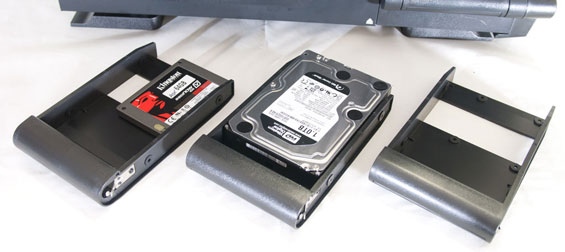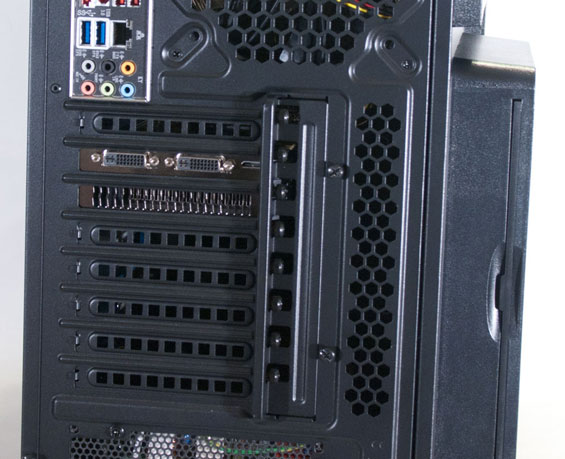Thermaltake Level 10 GT: Monument to Excess
by Dustin Sklavos on July 26, 2011 11:50 AM EST- Posted in
- Cases/Cooling/PSUs
- Thermaltake
- Full-Tower
Assembling the Thermaltake Level 10 GT
When you get north of the $140/$150 price point you do start to see a lot of unusual case designs begin to surface. Making a bog standard ATX case is reasonably easy, but tweaking and changing designs in an effort to improve both aesthetics and performance does take some effort. Likewise, the end user should be prepared for a little more thought and work to go into his or her build.
The Thermaltake Level 10 GT's assembly is actually less daunting than it looks, but it can be rife with minor nuisances. The absolute first thing you're going to want to do is take the hinged side panel off, and that's done by just opening it and then lifting it off the hinge. It's nice for quick and dirty changes internally, but for anything remotely more involved like installing a motherboard or expansion card, it needs to come off.

Someone over at Thermaltake heard my prayers when it came to motherboard installation, because I didn't have to install a single standoff into the motherboard tray. The exact standoffs for a bog standard ATX board were already in place and ready to go; all I had to do was pop in the I/O shield (a slightly tighter fit than usual) and then screw in the motherboard. It was incredibly painless.
Installing a 5.25" drive is also reasonably easy, with the bay shields designed to pop out of the front by squeezing the sides. It's a little unsightly but not a deal breaker, and the 5.25" drive is then clamped into place using a toolless clamp on the other side of the case. As I mentioned on the previous page, I do take issue with this, because I found it to be fairly difficult to get our optical drive to feel fully secure in the bay. Installing an external 3.5" drive is also a little fraught, as you'll have to carefully maneuver two screws into the enclosure to secure it in the bay.

The hot-swappable 3.5" drive bays are easy enough to install into. Each tray includes rubber grommet-lined mounting holes for both 2.5" and 3.5" drives, and that's much appreciated. It highlights a reason why using drive trays in modern enclosures is such a smart idea: it makes integrating 2.5" drive support much easier.

Unfortunately, having that smooth, flat rear (heads out of the gutter, kids) around the I/O shield and expansion ports creates an issue other enclosures don't have: there needs to be a way to secure expansion card brackets while giving space to work them into place. The result is that the Level 10 GT adds an extra step: you have to remove a small plate affixed with two thumbscrews and then remove the slot covers for the expansion slots before popping in the card.
Finally, installing the power supply is fairly easy and routing cables wasn't too problematic. There's a healthy amount of space behind the motherboard tray that it can be done without too much trouble, but you're probably still going to have to squish the side panel back down and on. The only power leads the enclosure requires are a single SATA power lead for the drive bays and a molex lead for the fans; the rear fan uses its own 3-pin lead allowing it to be controlled by the motherboard. That's a detail I actually really liked: Thermaltake seemed to know exactly which fan you'd want your hardware to control.
The takeaway with assembling the Level 10 GT is simple: remove the side panels completely, and then try to approach it like a regular enclosure. It will still take a bit of time and thought, but if you're buying a $270 case that shouldn't be a problem.
















46 Comments
View All Comments
KoolAidMan1 - Tuesday, July 26, 2011 - link
It is inferior in construction and design to Corsair and Silverstone cases, yet it costs more than most of them. Again, I don't see the point.kevith - Wednesday, July 27, 2011 - link
I don´t think it´s all that ugly. And actually, I´m surprised to see how many, that are willing to set looks over anything else when we´re talking an enthusiast case like this.To me it´s about cooling and noise, and in those fields this seems like an absolute winner.
The issue of the securing the drives doesn´t matter to me anyways, I´m am a silence-freak, so I always find a way and a place to hang my drives freely mounted in rubberbands. Every "silencing, rubber mounting grommets" I ever tried were absolutely worthless. And HDD hum is a major noise factor. Eliminated trough SSD´s of course.
(Frankly, I dont understand why manufacturers haven´t made up a "rubberband munting system long ago, and a caselike this isn´t supposed for lan-parties anyway.)
And the price: Come on, if you go for this case it´s probably going to last you a very long time, so if you take the price pr. year, it´s not more than a cheaper case, that´s likely to be swapped substantially sooner.
One thing about the price though: It´s not very nice to read about a poor paint job in this segment!!
But thumbs up for Kevin G.´s post, the fine review and the interesting case
CList - Wednesday, July 27, 2011 - link
So I have a question for other "enthusiasts" out there...If you have the means and/or prioritize your PC so much that you're willing to spend $250+ on a case - why on earth do you need that many drive bays? Is it a macho thing to have a large case or do you actually have that many drives that you want to keep?
I mean drives are so damn cheap these days... How many do you need? If you are willing to buy such an expensive case, then there's really no reason to own a drive that's smaller than maybe 750GB. Give the thing away and buy a larger one.
If you need 10TB of RAIDed storage isn't it a lot easier to just put it on a little NAS box that you can stick in the closet with your router?
Similarly for DVD drives - does anyone even have more than one now? What on earth do you use it for? I have one external USB-based BluRay drive that I plug in when I want to watch a movie or install some software, and then it goes back in the drawer for another two months.
I have a really hard time understanding why anyone would want so many drive bays - unless you're operating on a budget, in which case why would you buy this case or one like it? Is it a "mine is bigger than yours" thing?
Not trying to be critical, just curious...
Cheers,
CList
Dustin Sklavos - Wednesday, July 27, 2011 - link
NAS boxes still cost money, and even if they're RAIDed you're still looking at a bottleneck over the network interface.Honestly, I'd use all the 3.5" drive bays here. I edit video; I keep project files and personal data on a RAID 1, then my scratch disk and gaming drive is on a RAID 0. And then my system drive is on an SSD.
People out there will definitely use these drive bays.
As for optical drives, I have a blu-ray reader and then a blu-ray writer, so that's two right there. ODDs are becoming less and less important over time, but they're still relevant.
etamin - Friday, July 29, 2011 - link
Thinking as logically as I can, I think the bays only exist to fill up space, a decision by the manufacturer and not something a typical user looks for. With at least one bay and a hdd rack, the length of the case must become longer. If a full sized tower (sized based on mobo) were to maintain a semi box-like appearance, there would be a lot of empty space in the front end. Using that space for extra fans is less cost effective for manufacturers than simply adding racks to the chassis. Some makers go for hdd racks, and others go for bays.Just a thought..
just4U - Wednesday, July 27, 2011 - link
I build a fair number of systems and get to test out alot of cases because of that.. I keep thinking that perhaps it's time to go back to some older models since the designers of some of these cases need to be shot. I use 2 Lian-Li PC60 cases. (7 years now) and keep going back to them. Removable motherboard trays, Brushed aluminum, and just overall solid designs. I keep changing fans but that's it.I think.. make the case a little fatter to accomadate 120mm fans (front back) Move the Psu to the bottom, add a filter, add 1 140 or 200m fan to the top, add usb 3.0 and microphone/headphone jacks to the front.. you now have the perfect case. Call it a day. Even lian-li won't do it. Ticks me off. How hard can this be???
just4U - Wednesday, July 27, 2011 - link
and yes .. I know about the Lian Li PC-60FNW but it doesn't have a removable motherboard tray like the PC60,A,+ etc. Not sure why Lian-Li moved away from them because they were major selling points.etamin - Friday, July 29, 2011 - link
good news...what you want exists: Lian Li PC-V2120bad news...it's oversized and very expensive
corriellan - Wednesday, July 27, 2011 - link
I'm adopting this one.Conscript - Wednesday, July 27, 2011 - link
looks like we have another Stranger in a Strange Land fan...I smiled :)